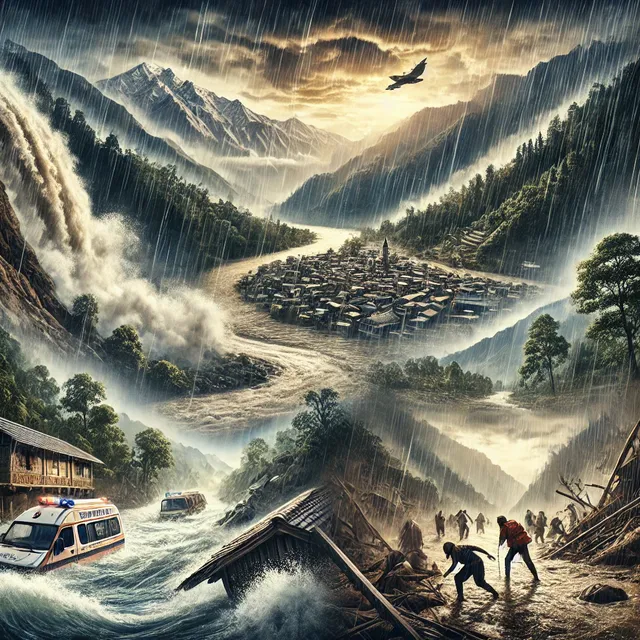The Perils of Monsoon in Uttarakhand, Nepal, and Himachal Pradesh
🌧️ The Perils of Monsoon in Uttarakhand, Nepal, and Himachal Pradesh 🌧️
The monsoon season, while essential for replenishing water sources and supporting agriculture, brings with it a host of dangers, particularly in the mountainous regions of Uttarakhand, Nepal, and Himachal Pradesh. These areas, characterized by their steep terrains and fragile ecosystems, are highly susceptible to natural disasters such as landslides, floods, and turbulent river currents. Understanding the risks associated with the monsoon in these regions is crucial for residents, travelers, and policymakers.
🌄 Landslides: A Persistent Threat
Causes of Landslides 🌧️
Landslides are a common occurrence during the monsoon season in the Himalayan regions. The primary cause is the saturation of soil and rock layers due to incessant rainfall. When the ground becomes overly saturated, it loses its stability, causing the soil and rocks to slide down slopes. Deforestation and unplanned construction exacerbate the problem by destabilizing the natural landscape.
Impact of Landslides 💔
The impact of landslides is devastating. They can lead to loss of life, destruction of homes, and severe damage to infrastructure such as roads and bridges. The mountainous terrain makes rescue operations challenging and time-consuming. In Uttarakhand, the Kedarnath disaster of 2013 is a grim reminder of the deadly potential of landslides, where thousands of lives were lost due to sudden landslides and flooding.
🌊 Floods: Rapid and Destructive
Causes of Floods 🌧️
Heavy monsoon rains can lead to rapid flooding in rivers and streams. In the steep valleys of the Himalayas, rainwater quickly accumulates and rushes downstream, often overwhelming the riverbanks and causing floods. Melting glaciers, accelerated by rising global temperatures, add to the volume of water during the monsoon, increasing the risk of flooding.
Impact of Floods 💔
Floods in these regions can be swift and destructive. Villages and towns located along riverbanks are particularly vulnerable. Floodwaters can inundate homes, wash away livestock, and destroy crops, leading to food shortages and economic hardship. The displacement of communities adds to the human toll, with many people losing their homes and livelihoods.
🌊 Turbulent River Currents: Hidden Dangers
Causes of Dangerous Currents 🌧️
During the monsoon season, rivers and streams swell with rainwater and glacial melt, resulting in fast-flowing and turbulent currents. The increased flow can dislodge boulders and debris, creating hazardous conditions for anyone near the water.
Impact of Turbulent Currents 💔
Strong river currents pose a significant risk to human life. People attempting to cross swollen rivers or those caught in the path of sudden floods can be swept away. The risk is not limited to remote areas; even urban regions in Nepal, Uttarakhand, and Himachal Pradesh have experienced the dangers of fast-moving waters. The rivers can erode riverbanks, undermining buildings and infrastructure.
🛠️ Mitigation and Preparedness
Government and Community Initiatives 🏢
Efforts to mitigate the impact of monsoon-related disasters include early warning systems, improved infrastructure, and community preparedness programs. Governments in Uttarakhand, Nepal, and Himachal Pradesh have been working to develop better forecasting and response mechanisms. However, the unpredictable nature of weather and the challenging terrain often limit these efforts.
Individual and Community Preparedness 🏠
Residents and travelers in these regions need to stay informed about weather forecasts and heed warnings from authorities. Communities are encouraged to develop local response plans, including identifying safe zones and stockpiling emergency supplies. Education on the dangers of monsoon and proper response strategies can save lives.
📝 Conclusion
The monsoon season in Uttarakhand, Nepal, and Himachal Pradesh brings with it the duality of life-sustaining rains and life-threatening disasters. Landslides, floods, and turbulent river currents pose significant risks to the inhabitants of these regions. While efforts are being made to mitigate these dangers, awareness and preparedness remain key to reducing the impact of these natural disasters. As climate change continues to influence weather patterns, the need for robust disaster management and resilient infrastructure becomes ever more critical.
Stay Safe During Monsoon! 🌧️
- Follow weather updates regularly.
- Avoid traveling to high-risk areas during heavy rains.
- Participate in community preparedness programs.
- Always have an emergency kit ready.
